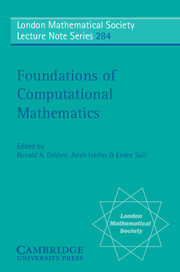Book contents
- Frontmatter
- Contents
- Preface
- Singularities and computation of minimizers for variational problems
- Adaptive finite element methods for flow problems
- Newton's method and some complexity aspects of the zero-finding problem
- Kronecker's smart, little black boxes
- Numerical analysis in Lie groups
- Feasibility control in nonlinear optimization
- Six lectures on the geometric integration of ODEs
- When are integration and discrepancy tractable?
- Moving frames — in geometry, algebra, computer vision, and numerical analysis
- Harmonic map flows and image processing
- Statistics from computations
- Simulation of stochastic processes and applications
- Real-time numerical solution to Duncan-Mortensen-Zakai equation
Kronecker's smart, little black boxes
Published online by Cambridge University Press: 05 August 2013
- Frontmatter
- Contents
- Preface
- Singularities and computation of minimizers for variational problems
- Adaptive finite element methods for flow problems
- Newton's method and some complexity aspects of the zero-finding problem
- Kronecker's smart, little black boxes
- Numerical analysis in Lie groups
- Feasibility control in nonlinear optimization
- Six lectures on the geometric integration of ODEs
- When are integration and discrepancy tractable?
- Moving frames — in geometry, algebra, computer vision, and numerical analysis
- Harmonic map flows and image processing
- Statistics from computations
- Simulation of stochastic processes and applications
- Real-time numerical solution to Duncan-Mortensen-Zakai equation
Summary
Abstract
This paper is devoted to the complexity analysis of certain uniformity properties owned by all known symbolic methods of parametric polynomial equation solving (geometric elimination). It is shown that any parametric elimination procedure which is parsimonious with respect to branchings and divisions must necessarily have a non-polynomial sequential time complexity, even if highly efficient data structures (as e.g. the arithmetic circuit encoding of polynomials) are used.
Introduction
Origins, development and interaction of modern algebraic geometry and commutative algebra may be considered as one of the most illustrative examples of historical dialectics in mathematics. Still today, and more than ever before, timeless idealism (in form of modern commutative algebra) is bravely struggling whith secular materialism (in form of complexity issues in computational algebraic geometry).
Kronecker was doubtless the creator of this eternal battle field and its first war lord. In a similar way as Gauss did for computational number theory, Kronecker laid intuitively the mathematical foundations of modern computer algebra. He introduced 1882 in [30] his famous “elimination method” for polynomial equation systems and his “parametric representation” of (equidimensional) algebraic varieties. By the way, this parametric representation was until 10 years ago rediscovered again and again. It entered in modern computer algebra as “Shape Lemma” (see e.g. [38, 8, 14, 27]). Using his elimination method in a highly skillful, but unfortunately inimitable way, Kronecker was able to state and to prove a series of fundamental results on arbitrary algebraic varieties.
- Type
- Chapter
- Information
- Foundations of Computational Mathematics , pp. 69 - 104Publisher: Cambridge University PressPrint publication year: 2001
- 8
- Cited by

